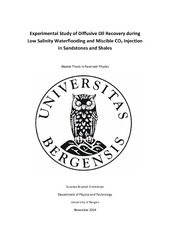Experimental study of diffusive oil recovery during low salinity waterflooding and miscible CO2 injection in sandstones and shales
Master thesis
Permanent lenke
https://hdl.handle.net/1956/9210Utgivelsesdato
2014-11-24Metadata
Vis full innførselSamlinger
Sammendrag
This experimental thesis presents a study of two diffusive EOR techniques; low salinity waterflooding in 2D sandstone silicon wafer micromodels and miscible CO2 injection in tight shale core samples. Tests were conducted using both refined oils and crude oil. During low salinity waterflooding, a salinity gradient was set up between low salinity water injected through a fracture and a porous network partially saturated with high salinity brine. Primary drained oil acted as a semi-permeable membrane between the two aqueous phases. As part of a recently started CO2 project, experiments involved injection of liquid and supercritical CO2 through tight shale cores to produce oil primarily by molecular diffusion. Osmotic diffusion in presence of a salinity gradient resulted in increased water flux and oil mobilization, visualized within separate pores and in networks of interconnected pores. Diffusive transport mechanisms were identified as water diffusion through film-flow and osmosis. Two effective processes were observed by the identified mechanisms, 1) water dispersion and water droplet growth and 2) residual oil displacement and mobilization. Water flux through a refined oil membrane increased with brine salinity and decreased with increasing oil carbon number. Highest oil displacement and mobilization was observed with low carbon numbered oil (n-Hexane) and moderate high salinity brine (5%wtNaCl). Water diffusion film-flow caused oil mobilization and redistribution in a continuous crude oil membrane. Expansion in a residual crude oil membrane was caused by osmosis. Initial oil recovery results during CO2 injection in tight shales are reported. Shale permeabilities during CO2 injection were estimated to be of 10^-2\muD range. Recovery from miscible CO2 injection in tight shale samples ranged from 76% to 114%OOIP including both refined and crude oil. Recovery exceeded 100%OOIP for the n-Decane experiments due to residual production of immobile crude oil. Errors associated with density of the produced fluids and the porosity estimates of shale cores provide basis for large experimental uncertainties. Dynamic production results showed gas breakthrough after 1 PV CO2 injected, the effective recovery mechanism being molecular diffusion to displace unrecovered oil. Approximately 60 PVs were injected to obtain a recovery of 71%OOIP using n-Decane. Miscible CO2 injection could have the potential of producing 100%OOIP given large enough quantities of CO2.
